 One-Way Street?
One-Way Street?
For every painter or graphic artist who appropriates or derives iconography and other content from photographs, there’s a photographer who imitates or otherwise bases work on paintings, as I indicated in my previous post.
Yet I find remarkable differences between photographers and other visual artists vis-a-vis this practice, differences that fall outside the actual craft and creative activities involved.
• First, photographers and their representatives sue others for copyright violations at an astonishing rate, compared to painters and other graphic artists. They sue other photographers (see Gordon v. McGinley); they sue videographers (see David LaChapelle v. Rihanna/Melina Matsoukas); they sue sculptors (see Rogers v. Koons); and they sue painters and graphic artists (see below). In some cases they prevail, in others they don’t, but photographers frequently turn litigious when anyone borrows from them.
• Second, artists in other visual media generally turn a blind eye to photographers’ borrowings from their works (see previous post). I haven’t researched this thoroughly, but a Google search for “painter sues photographer copyright violation” turned up no single relevant result. (I’ll welcome instances supplied by my readers.)
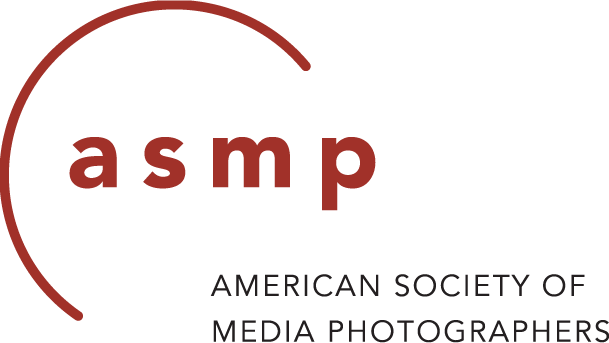 • Third, photographers ― including those who sue others for borrowing from them ― stay mum when their fellow practitioners of the lens-based media borrow from copyrighted works in other visual media. So do their professional organizations, such as the American Society of Media Photographers, though these collectives dependably rally around photographers whose work gets appropriated.
• Third, photographers ― including those who sue others for borrowing from them ― stay mum when their fellow practitioners of the lens-based media borrow from copyrighted works in other visual media. So do their professional organizations, such as the American Society of Media Photographers, though these collectives dependably rally around photographers whose work gets appropriated.
• Fourth, some art critics and cultural journalists come down extremely hard on painters who work from photographs, as enumerated in previous posts. However, they too usually stay mum when photographers borrow from works in other visual media; in some cases, they celebrate these activities. Meanwhile, photography critics seem to have nothing to say on the general issue, though they offer opinions ― generally praiseful ― on specific instances.
Whence this disconnect? Does the hypocrisy bother no one save me?
Three Major Cases
The three most prominent 21st-century cases of unauthorized appropriations of photographs by painters are, in chronological order, Joy Garnett‘s 2003 interpretation, in a painting titled “Molotov,” of the central figure in the iconic “Molotov Man” photograph made by Susan Meiselas in Nicaragua in 1979 and copyrighted by her; Richard Prince’s use in 2007 of some three dozen copyrighted images of Rastafarians by Patrick Cariou from his 2000 book Yes Rasta; and Shepard Fairey’s 2008 adaptation for his “Hope” poster of an April 2006 Associated Press photograph of Barack Obama by freelance photographer Mannie Garcia, all rights to which are owned by the AP.
Garnett/Meiselas and “Molotov Man”
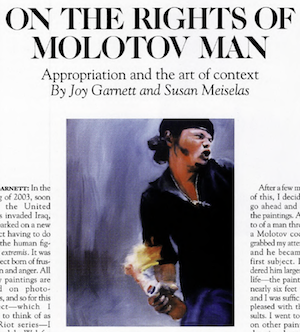
Harper’s Magazine, February 2007, page 53, detail.
The Garnett/Meiselas dispute got resolved out of court, with the threat of a lawsuit inspiring a subsequent agreement from Garnett to remove the jpeg of that painting from her website and credit the photographer in all future showings and reproductions of this work, with no licensing fees involved. (Click here for a transcription of a thoughtful exchange between the two principals, as published in Harper’s in 2007.) I haven’t seen the original painting, but, from the reproductions, Garnett’s effort doesn’t strike me as significantly more “transformative” than Bob Dylan’s reworkings of a handful of photographs.
The parallels with Bob Dylan’s painterly practice (which triggered this series of posts) seem obvious, as do the disparities between their professional behavior: Dylan paid a licensing fee for his usages, Garnett simply took what she wanted. Yet Ann Binlot, Richard Polsky, Mallika Rao and their ilk, who piled on Dylan for painting from photographs, haven’t accused Garnett of “ripping off,” “stealing,” “plagiarism,” “intellectual theft,” “line-for-line mimicry,” or any other sin. No, on this their lips remain sealed. So much for consistency, not to mention intellectual integrity, among these critics and cultural journalists.
Prince/Cariou and Yes Rasta
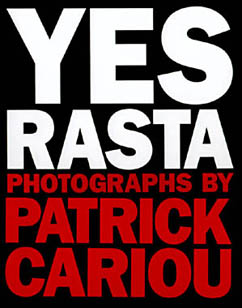
Patrick Cariou, “Yes Rasta” (2000), cover.
The Prince/Cariou contretemps worked its way up the Federal court system; initially, the District Court sided with Cariou. Most recently, on appeal, this past April the Second Circuit of the Federal Court held mostly in favor of Prince, based on the “fair use” exception to the copyright law, using reasoning that I find opaque. (Click here for a synopsis of the decision at LawUpdates.com.) As the New York Art Law Blog opines,
“This decision represents a coup for appropriation art, and will make it more difficult for plaintiffs to prove that unauthorized derivative works constitute copyright infringement unless those works are almost identical to the original work. This is perhaps indicative of a shift in our society where creative works are routinely undervalued and appropriation art and illegal downloading are increasingly more common and more socially acceptable.”
Fairey/Garcia and “Hope”
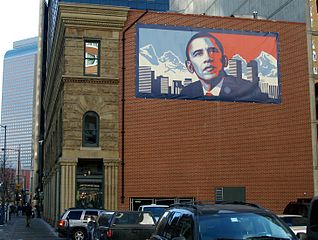
Building in Denver, CO, with Shepard Fairey poster of Obama, 2009. Photo by David Shankbone, courtesy Creative Commons.
Shepard Fairey’s poster became an iconic image during then-Senator Barack Obama’s first run for the White House. Once the image’s source became identified, the Associated Press demanded compensation. (Freelancer Mannie Garcia, who had made the source image in 2006 while on assignment for the AP, believed he had retained copyright, but later dropped that claim.)
Fairey countersued for a declaratory judgment that his poster constituted fair use of the original photo. In January 2011 the parties settled out of court, when the judge told Fairey that, on the merits, he would lose; details remain confidential. Here’s the Wikipedia summation of the case.
Fairey subsequently pleaded guilty in a New York federal court to destroying and fabricating documents during this legal battle. He was sentenced to two years of probation, 300 hours of community service, and a fine of $25,000.
Fairey’s done this before, with photographs by others. As with the instances above, the comparison with Dylan proves instructive: Dylan elected to pay for the appropriate licenses, Fairey took without asking or ponying up. (I should add that Fairey vigorously defends his own copyright-protected works against use by other artists. Talk about gall.)
•
In the first two instances artists and the art world rallied around the artists, in the case of Garnett waging what got dubbed Joywar! on the original image and its maker, digitally flashmobbing Meiselas. The Andy Warhol Foundation for the Visual Arts filed an amicus brief in support of Prince, which figures, given Warhol’s penchant for appropriation.(Click here to read and/or download that document.) So did the Center for Internet and Society at Stanford Law School. (Worth noting that, as pointed out in “No longer appropriate?” Laura Gilbert’s May 9, 2012 report for The Art Newspaper, Warhol faced lawsuits in the 1960s for unauthorized use of photographs by Patricia Caulfield, Fred Ward, and Charles Moore. he settled out of court in all three cases, deciding thereafter to license rights to photos by others.)
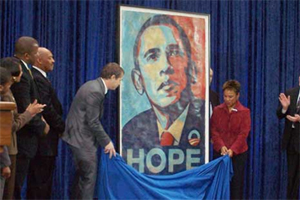
Shepard Fairey, “Hope,” National Portrait Gallery, installation, 2009. Photo courtesy National Portrait Gallery.
For reasons unclear, Fairey’s case did not evoke substantial art-world support, though, in 2009, the Smithsonian Institution’s National Portrait Gallery announced it had acquired his original hand-finished collage version of the image. During the legal proceedings he was represented by Anthony Falzone, executive director of the Fair Use Project at Stanford University.
The Photographers Archive Council of America, which represents Corbis and Getty, and the American Society of Media Photographers, joined by 7000 individual photographers, filed an amicus brief in support of Cariou. (Click here to read and/or download that document.)
•
What, if anything, can we glean from the outcome of these situations?
In the cases of Garnett and Fairey, lawsuits or the threat thereof resulted in out-of-court settlements in favor of the photographers or their agencies, Meiselas and the Associated Press, respectively. In the case of Prince, the courts swung like pendula as the case climbed the appeals ladder, ultimately resolving decisively in favor of Prince.
So the threat of legal action may work for photographers, at least on artists like Garnett and Fairey, who lack the funds for a protracted legal tussle. But the law’s now on the side of those who borrow, not those who originate what’s borrowed, with an increasingly broad interpretation of the “fair use” exception to the copyright statutes.
Moreover, by imitating paintings as freely and frequently as they do, and by tolerating and even endorsing such activity by their fellow practitioners, photographers undercut themselves and their colleagues who object to such infringements on the part of visual artists, abandoning any claim to the moral high ground. Were I the attorney for John Currin, should he decide to sue photographer Peter Lindbergh for replicating my client’s 1997 painting “The Cripple,” I’d submit Susan Meiselas’s rationale for her objections to the decontextualization of her image as supporting documentation.
Can We Talk?
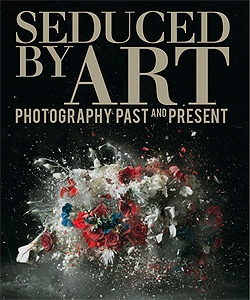
“Seduced by Art: Photography Past and Present” (2012), cover.
The interchange between still photography and the graphic arts has been extensive, flowing in both directions. Many books have annotated it, and exhibitions such as “Seduced by Art: Photography Past and Present” at the National Gallery in London this past year have paired photographs with the works from which they derived, and vice versa. It’s a two-way street. (Laura Cumming’s nuanced review of this show in the London Observer is worth reading.)
For that very reason, what’s sauce for the goose must get treated as gander gravy. If, from a critical standpoint, it’s creatively disreputable for painters to replicate photographs with great precision or work from them more loosely, then the same must apply to photographers responding to paintings and other works of visual art. Critics who denounce the first practice yet have nothing to say about the second define themselves as hypocrites. (Yes, Ann Binlot, Richard Polsky, Mallika Rao, I’m talking to you.) As a critic, you either have a principled position on such usages in both directions or you’re simply opportunistic when castigating one while ignoring others.
From a legal standpoint, if graphic artists are required to seek permissions and, if granted, license rights for usages of copyrighted photographs, then photographers surely have an obligation to do the same when basing their images on works in other media. Failure to insist on this quid pro quo by establishing a principled position regarding appropriation by photographers brands the membership of the ASMP and other organizations of photographers as two-faced and self-serving. Shame on them.
•
For an index of links to all posts related to this story, click here.
•
This post supported by a donation from Norbert Kleber.
The Photographer and the Painting (3)
For every painter or graphic artist who appropriates or derives iconography and other content from photographs, there’s a photographer who imitates or otherwise bases work on paintings, as I indicated in my previous post.
Yet I find remarkable differences between photographers and other visual artists vis-a-vis this practice, differences that fall outside the actual craft and creative activities involved.
• First, photographers and their representatives sue others for copyright violations at an astonishing rate, compared to painters and other graphic artists. They sue other photographers (see Gordon v. McGinley); they sue videographers (see David LaChapelle v. Rihanna/Melina Matsoukas); they sue sculptors (see Rogers v. Koons); and they sue painters and graphic artists (see below). In some cases they prevail, in others they don’t, but photographers frequently turn litigious when anyone borrows from them.
• Second, artists in other visual media generally turn a blind eye to photographers’ borrowings from their works (see previous post). I haven’t researched this thoroughly, but a Google search for “painter sues photographer copyright violation” turned up no single relevant result. (I’ll welcome instances supplied by my readers.)
• Fourth, some art critics and cultural journalists come down extremely hard on painters who work from photographs, as enumerated in previous posts. However, they too usually stay mum when photographers borrow from works in other visual media; in some cases, they celebrate these activities. Meanwhile, photography critics seem to have nothing to say on the general issue, though they offer opinions ― generally praiseful ― on specific instances.
Whence this disconnect? Does the hypocrisy bother no one save me?
Three Major Cases
The three most prominent 21st-century cases of unauthorized appropriations of photographs by painters are, in chronological order, Joy Garnett‘s 2003 interpretation, in a painting titled “Molotov,” of the central figure in the iconic “Molotov Man” photograph made by Susan Meiselas in Nicaragua in 1979 and copyrighted by her; Richard Prince’s use in 2007 of some three dozen copyrighted images of Rastafarians by Patrick Cariou from his 2000 book Yes Rasta; and Shepard Fairey’s 2008 adaptation for his “Hope” poster of an April 2006 Associated Press photograph of Barack Obama by freelance photographer Mannie Garcia, all rights to which are owned by the AP.
Garnett/Meiselas and “Molotov Man”
Harper’s Magazine, February 2007, page 53, detail.
The Garnett/Meiselas dispute got resolved out of court, with the threat of a lawsuit inspiring a subsequent agreement from Garnett to remove the jpeg of that painting from her website and credit the photographer in all future showings and reproductions of this work, with no licensing fees involved. (Click here for a transcription of a thoughtful exchange between the two principals, as published in Harper’s in 2007.) I haven’t seen the original painting, but, from the reproductions, Garnett’s effort doesn’t strike me as significantly more “transformative” than Bob Dylan’s reworkings of a handful of photographs.
The parallels with Bob Dylan’s painterly practice (which triggered this series of posts) seem obvious, as do the disparities between their professional behavior: Dylan paid a licensing fee for his usages, Garnett simply took what she wanted. Yet Ann Binlot, Richard Polsky, Mallika Rao and their ilk, who piled on Dylan for painting from photographs, haven’t accused Garnett of “ripping off,” “stealing,” “plagiarism,” “intellectual theft,” “line-for-line mimicry,” or any other sin. No, on this their lips remain sealed. So much for consistency, not to mention intellectual integrity, among these critics and cultural journalists.
Prince/Cariou and Yes Rasta
Patrick Cariou, “Yes Rasta” (2000), cover.
The Prince/Cariou contretemps worked its way up the Federal court system; initially, the District Court sided with Cariou. Most recently, on appeal, this past April the Second Circuit of the Federal Court held mostly in favor of Prince, based on the “fair use” exception to the copyright law, using reasoning that I find opaque. (Click here for a synopsis of the decision at LawUpdates.com.) As the New York Art Law Blog opines,
“This decision represents a coup for appropriation art, and will make it more difficult for plaintiffs to prove that unauthorized derivative works constitute copyright infringement unless those works are almost identical to the original work. This is perhaps indicative of a shift in our society where creative works are routinely undervalued and appropriation art and illegal downloading are increasingly more common and more socially acceptable.”
Fairey/Garcia and “Hope”
Building in Denver, CO, with Shepard Fairey poster of Obama, 2009. Photo by David Shankbone, courtesy Creative Commons.
Shepard Fairey’s poster became an iconic image during then-Senator Barack Obama’s first run for the White House. Once the image’s source became identified, the Associated Press demanded compensation. (Freelancer Mannie Garcia, who had made the source image in 2006 while on assignment for the AP, believed he had retained copyright, but later dropped that claim.)
Fairey countersued for a declaratory judgment that his poster constituted fair use of the original photo. In January 2011 the parties settled out of court, when the judge told Fairey that, on the merits, he would lose; details remain confidential. Here’s the Wikipedia summation of the case.
Fairey subsequently pleaded guilty in a New York federal court to destroying and fabricating documents during this legal battle. He was sentenced to two years of probation, 300 hours of community service, and a fine of $25,000.
Fairey’s done this before, with photographs by others. As with the instances above, the comparison with Dylan proves instructive: Dylan elected to pay for the appropriate licenses, Fairey took without asking or ponying up. (I should add that Fairey vigorously defends his own copyright-protected works against use by other artists. Talk about gall.)
•
In the first two instances artists and the art world rallied around the artists, in the case of Garnett waging what got dubbed Joywar! on the original image and its maker, digitally flashmobbing Meiselas. The Andy Warhol Foundation for the Visual Arts filed an amicus brief in support of Prince, which figures, given Warhol’s penchant for appropriation.(Click here to read and/or download that document.) So did the Center for Internet and Society at Stanford Law School. (Worth noting that, as pointed out in “No longer appropriate?” Laura Gilbert’s May 9, 2012 report for The Art Newspaper, Warhol faced lawsuits in the 1960s for unauthorized use of photographs by Patricia Caulfield, Fred Ward, and Charles Moore. he settled out of court in all three cases, deciding thereafter to license rights to photos by others.)
Shepard Fairey, “Hope,” National Portrait Gallery, installation, 2009. Photo courtesy National Portrait Gallery.
For reasons unclear, Fairey’s case did not evoke substantial art-world support, though, in 2009, the Smithsonian Institution’s National Portrait Gallery announced it had acquired his original hand-finished collage version of the image. During the legal proceedings he was represented by Anthony Falzone, executive director of the Fair Use Project at Stanford University.
The Photographers Archive Council of America, which represents Corbis and Getty, and the American Society of Media Photographers, joined by 7000 individual photographers, filed an amicus brief in support of Cariou. (Click here to read and/or download that document.)
•
What, if anything, can we glean from the outcome of these situations?
In the cases of Garnett and Fairey, lawsuits or the threat thereof resulted in out-of-court settlements in favor of the photographers or their agencies, Meiselas and the Associated Press, respectively. In the case of Prince, the courts swung like pendula as the case climbed the appeals ladder, ultimately resolving decisively in favor of Prince.
So the threat of legal action may work for photographers, at least on artists like Garnett and Fairey, who lack the funds for a protracted legal tussle. But the law’s now on the side of those who borrow, not those who originate what’s borrowed, with an increasingly broad interpretation of the “fair use” exception to the copyright statutes.
Moreover, by imitating paintings as freely and frequently as they do, and by tolerating and even endorsing such activity by their fellow practitioners, photographers undercut themselves and their colleagues who object to such infringements on the part of visual artists, abandoning any claim to the moral high ground. Were I the attorney for John Currin, should he decide to sue photographer Peter Lindbergh for replicating my client’s 1997 painting “The Cripple,” I’d submit Susan Meiselas’s rationale for her objections to the decontextualization of her image as supporting documentation.
Can We Talk?
“Seduced by Art: Photography Past and Present” (2012), cover.
The interchange between still photography and the graphic arts has been extensive, flowing in both directions. Many books have annotated it, and exhibitions such as “Seduced by Art: Photography Past and Present” at the National Gallery in London this past year have paired photographs with the works from which they derived, and vice versa. It’s a two-way street. (Laura Cumming’s nuanced review of this show in the London Observer is worth reading.)
For that very reason, what’s sauce for the goose must get treated as gander gravy. If, from a critical standpoint, it’s creatively disreputable for painters to replicate photographs with great precision or work from them more loosely, then the same must apply to photographers responding to paintings and other works of visual art. Critics who denounce the first practice yet have nothing to say about the second define themselves as hypocrites. (Yes, Ann Binlot, Richard Polsky, Mallika Rao, I’m talking to you.) As a critic, you either have a principled position on such usages in both directions or you’re simply opportunistic when castigating one while ignoring others.
From a legal standpoint, if graphic artists are required to seek permissions and, if granted, license rights for usages of copyrighted photographs, then photographers surely have an obligation to do the same when basing their images on works in other media. Failure to insist on this quid pro quo by establishing a principled position regarding appropriation by photographers brands the membership of the ASMP and other organizations of photographers as two-faced and self-serving. Shame on them.
•
For an index of links to all posts related to this story, click here.
•
This post supported by a donation from Norbert Kleber.